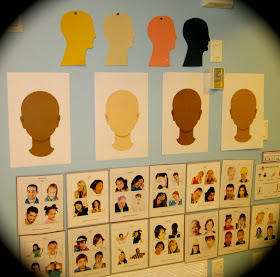 |
| Water gels to help children feel calm. |
When children or adults have problems processing visual,
auditory, tactile, olfactive, gustatory, vestibular, and proprioceptive
information from the environment around them, they may have a sensory processing
disorder. This is a neurological disorder causing difficulties with taking in,
processing, and responding to sensory information. Many of the people that I
work with, have some difficulty with processing sensory information. At some
time most of us have experienced sensory overload; perhaps while shopping in
malls, driving in traffic or attending a concert.
Sensory over responsively can cause a person to go into a
fight or flight reaction. Certain sounds (a school bell, someone yelling),
scents (perfume, hair shampoo), or sights (flashing lights, fluorescent
lights), and or feels (tags on clothing, chalk) may cause a child to run away
or scream in fright. One client I work with spends to first 5 minutes checking
out everything in the art rooms to make sure that he knows what is new, what
others are doing and make sure that he is not missing anything. I always play
the same soothing music, burn lavender oil and talk and walk slowly when he is
here to help calm down his autonomic nervous system and help regulate his
sensory input to a more manageable level. After about 5 minutes, he can settle
into a focused and productive session.
 |
| Blue lights for calming. |
Sensory seeking means that people in this range seek intense
and extreme sensory input. They may not feel pain and they may make sounds with
their mouths as a way to stimulate their auditory systems. They often play
rough and have poor impulse control. I have a client who would throw and
spatter paint for half an hour onto a 2 metre long sheet of paper hanging on
the wall before he could settle into his body and relax. Now he happily plays
in the sand trays as we process his experiences.
 |
| Sand tray |
The sensory work that I do in my therapy room is geared to
help normalize the senses. Children with dyspraxia have a low awareness of
their body in space and lack an ability to feel or sense where their body begins
and ends. I use many different body awareness techniques to help children relocate
themselves in their body. Poor muscle control, poor balance are often also
experienced by children and adults who have sensory issues.
So, how can art therapy help? First, by creating an
atmosphere that is sensory friendly. I have low lights, coloured lights, soft
music, aromatherapy, calm wall spaces and a slowed down environment that has
limited stimulation so children and adults have less sensory input to deal with
when they enter the therapy space. I use biofeedback, EMDR, breathing
exercises, a children’s meditation program and other processes that help
children and adults tolerate being in their body at a slowed down speed. I have
water gels to help calm the senses. Sand tray work is wonderful for helping
children learn to tolerate and enjoy different textures and feels. Playing in
sand is one way children can practice sensory integration. Sensory integration
is the neurological process that helps us interact with our environment through
using our senses. The brain needs to be able to process multiple sensory inputs.
Sensory integration is
necessary for almost every activity that we perform because the combination of
multiple sensory inputs is essential for us to comprehend our surroundings.
 |
| Water gels. |




































